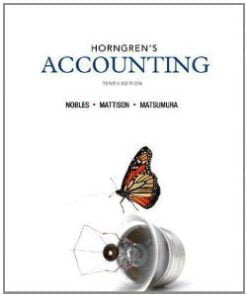Solution Manual for Introduction to Engineering Analysis 4/E 4th Edition Kirk D. Hagen
$55.00 Original price was: $55.00.$29.99Current price is: $29.99.
Solution Manual for Introduction to Engineering Analysis, 4/E 4th Edition Kirk D. Hagen
This is completed downloadable of Solution Manual for Introduction to Engineering Analysis, 4/E 4th Edition Kirk D. Hagen

Product Details:
- ISBN-10 : 9780133485080
- ISBN-13 : 978-0133485080
- Author: Kirk D. Hagen
For use in the first-year engineering course. This text is also suitable for individuals interested in adopting a problem-solving approach to engineering problems.
The goal of this text is to introduce a general problem-solving approach for the beginning engineering student. Thus, Introduction to Engineering Analysis focuses on how to solve (any) kind of engineering analytical problem in a logical and systematic way. The book helps to prepare the students for such analytically oriented courses as statics, strength of materials, electrical circuits, fluid mechanics, thermodynamics, etc.
Table of Content:
- Chapter 1 The Role of Analysis in Engineering
- Objectives
- 1.1 Introduction
- 1.2 Analysis and Engineering Design
- 1.3 Analysis and Engineering Failure
- Key Terms
- References
- Problems
- Analysis and engineering design
- Analysis and engineering failure
- Chapter 2 Dimensions and Units
- Objectives
- 2.1 Introduction
- 2.2 Dimensions
- Example 2.1
- Solution
- Example 2.2
- Solution
- Example 2.3
- Solution
- Practice!
- 2.3 Units
- 2.4 SI Units
- Practice!
- 2.5 English Units
- 2.6 Mass and Weight
- Example 2.4
- Solution
- Example 2.5
- Solution
- Practice!
- 2.7 Unit Conversions
- Key Terms
- References
- Problems
- Dimensions
- Units
- Mass and weight
- Unit conversions
- Chapter 3 Analysis Methodology
- Objectives
- 3.1 Introduction
- 3.2 Numerical Calculations
- 3.2.1 Approximations
- Example 3.1
- Solution
- 3.2.2 Significant Figures
- Example 3.2
- Solution
- Example 3.3
- Solution
- Practice!
- 3.3 General Analysis Procedure
- 3.4 The Computer as an Analysis Tool
- 3.4.1 Spreadsheets
- 3.4.2 Equation Solvers and Mathematics Software
- 3.4.3 Programming Languages
- 3.4.4 Specialty Software
- 3.4.5 Finite Element Software
- Practice!
- Key Terms
- References
- Problems
- Order-of-magnitude analysis
- Significant figures
- General analysis procedure
- Chapter 4 Mechanics
- Objectives
- 4.1 Introduction
- 4.2 Scalars and Vectors
- 4.2.1 Vector Operations
- 4.2.2 Vector Components
- 4.2.3 Unit Vectors
- Example 4.1
- Solution
- (a) Parallelogram law
- (b) Vector components
- Example 4.2
- Solution
- 4.3 Forces
- Example 4.3
- Solution
- Practice!
- 4.4 Free-Body Diagrams
- Practice!
- 4.5 Equilibrium
- Example 4.4
- Problem statement
- Diagram
- Assumptions
- Governing equations
- Calculations
- Solution Check
- Discussion
- Example 4.5
- Problem statement
- Diagram
- Assumptions
- Governing equations
- Calculations
- Solution check
- Discussion
- Practice!
- 4.6 Stress and Strain
- 4.6.1 Stress
- 4.6.2 Strain
- 4.6.3 Hooke’s Law
- 4.6.4 Stress–Strain Diagram
- Example 4.6
- Problem statement
- Diagram
- Assumptions
- Governing equations
- Calculations
- Solution check
- Discussion
- Practice!
- 4.7 Design Stress
- Problem statement
- Diagram
- Assumptions
- Governing equations
- Calculations
- Solution check
- Discussion
- Practice!
- Key Terms
- References
- Problems
- Forces
- Free-body diagrams
- Equilibrium
- Stress and strain
- Design stress
- Chapter 5 Electrical Circuits
- Objectives
- 5.1 Introduction
- 5.2 Electric Charge And Current
- Example 5.1
- Solution
- Practice!
- 5.3 Voltage
- Practice!
- 5.4 Resistance
- Example 5.2
- Solution
- Practice!
- 5.5 Ohm’S Law
- Practice!
- 5.6 Simple DC Circuits
- Example 5.3
- Problem Statement
- Diagram
- Assumptions
- Governing equations
- Calculations
- Solution check
- Discussion
- Example 5.4
- Problem statement
- Diagram
- Assumptions
- Governing equations
- Calculations
- Solution check
- Discussion
- Practice!
- 5.7 Kirchhoff’s Laws
- 5.7.1 Kirchhoff’s Current Law
- 5.7.2 Kirchhoff’s Voltage Law
- Example 5.5
- Problem statement
- Diagram
- Assumptions
- Governing equations
- Calculations
- Solution check
- Discussion
- Practice!
- Key Terms
- References
- Problems
- Electric charge and current
- Voltage
- Resistance
- Ohm’s law
- Simple DC circuits
- Kirchhoff’s Laws
- Chapter 6 Thermodynamics
- Objectives
- 6.1 Introduction
- 6.2 Pressure and Temperature
- 6.2.1 Pressure
- 6.2.2 Temperature
- Example 6.1
- Solution
- Example 6.2
- Solution
- Practice!
- 6.3 Forms of Energy
- 6.3.1 Potential Energy
- 6.3.2 Kinetic Energy
- 6.3.3 Internal Energy
- 6.3.4 Total Energy
- 6.4 Work and Heat
- 6.4.1 Mechanical Work
- Gravitational work
- Acceleration work
- Boundary work
- Shaft work
- Spring work
- 6.4.2 Heat
- Example 6.3
- Problem statement
- Diagram
- Assumptions
- Governing equations
- Calculations
- Solution check
- Discussion
- Practice!
- 6.5 The First Law of Thermodynamics
- Example 6.4
- Problem statement
- Diagram
- Assumptions
- Governing equations
- Calculations
- Solution check
- Discussion
- Example 6.5
- Problem statement
- Diagram
- Assumptions
- Governing equations
- Calculations
- Solution check
- Discussion
- Practice!
- 6.6 Heat Engines
- Example 6.6
- Solution
- 6.7 The Second Law of Thermodynamics
- Practice!
- Key Terms
- References
- Problems
- Pressure and temperature
- Work and heat
- First law of thermodynamics
- Heat engines
- Second law of thermodynamics
- Chapter 7 Fluid Mechanics
- Objectives
- 7.1 Introduction
- 7.2 Fluid Properties
- 7.2.1 Density, Specific Weight, and Specific Gravity
- 7.2.2 Bulk Modulus
- 7.2.3 Viscosity
- Example 7.1
- Solution
- Example 7.2
- Solution
- Example 7.3
- Solution
- Practice!
- 7.3 Fluid Statics
- 7.3.1 Pressure–Elevation Relationship
- 7.3.2 Forces on Submerged Surfaces
- Example 7.4
- Solution
- Practice!
- 7.4 Flow Rates
- Example 7.5
- Solution
- Practice!
- 7.5 Conservation of Mass
- Example 7.6
- Problem Statement
- Diagram
- Assumptions
- Governing equations
- Calculations
- Solution check
- Discussion
- Practice!
- Key Terms
- References
- Problems
- Fluid properties
- Fluid statics
- Flow rates
- Conservation of mass
- Chapter 8 Renewable Energy
- Objectives
- 8.1 Introduction
- 8.1.1 Environmental Considerations
- 8.2 Solar
- 8.2.1 Solar Energy Systems
- 8.2.2 Photovoltaic Systems
- Example 8.1
- Solution
- Example 8.2
- Solution
- linePractice!
- 8.3 Wind
- 8.3.1 Basic Energy Analysis of a Horizontal Axis Wind Turbine
- Example 8.3
- Solution
- Practice!
- 8.4 Hydro
- 8.4.1 Basic Energy Analysis of a Hydropower Plant
- Example 8.4
- Solution
- Practice!
- 8.5 Geothermal
- 8.5.1 Basic Energy Analysis of a Binary Plant
- Example 8.5
- Solution
- Practice!
- 8.6 Marine
- 8.6.1 Tidal
- 8.6.2 Ocean
- 8.6.2.1 Ocean Currents
- Example 8.6
- Solution
- 8.6.2.2 Ocean Waves
- Example 8.7
- Solution
- 8.6.2.3 Ocean Thermal Energy
- Example 8.8
- Solution
- Practice!
- 8.7 Biomass
- Key Terms
- References
- Problems
- Solar
- Wind
- Hydro
- Geothermal
- Marine
- Biomass
- Chapter 9 Data Analysis: Graphing
- Objectives
- 9.1 Introduction
- 9.2 Collecting and Recording Data
- 9.2.1 Data Identification and Association
- 9.2.2 Accuracy, Precision, and Error
- 9.2.3 Recording Data
- Practice!
- 9.3 General Graphing Procedure
- 9.3.1 Dependent and Independent Variables
- 9.3.2 Variable Ranges
- 9.3.3 Graph Paper
- 9.3.4 Location of Axes
- 9.3.5 Graduation and Calibration of Axes
- 9.3.6 Axis Labels
- 9.3.7 Data Point Plotting
- 9.3.8 Curves
- 9.3.9 Legends and Titles
- 9.3.10 Graphing with Computer Software
- Practice!
- 9.4 Curve Fitting
- 9.4.1 Common Mathematical Functions
- 9.4.2 Method of Selected Points
- Example 9.1
- Solution
- Example 9.2
- Solution
- Example 9.3
- Solution
- 9.4.3 Least Squares Linear Regression
- Example 9.4
- Solution
- Example 9.5
- Solution
- Practice!
- 9.5 Interpolation and Extrapolation
- Practice!
- Key Terms
- References
- Problems
- Collecting and recording data
- General graphing procedure
- Curve fitting
- Interpolation and extrapolation
- Chapter 10 Data Analysis: Statistics
- Objectives
- 10.1 Introduction
- 10.2 Data Classification and Frequency Distribution
- Practice!
- 10.3 Measures of Central Tendency
- 10.3.1 Mean
- 10.3.2 Median
- 10.3.3 Mode
- Example 10.1
- Solution
- 10.4 Measures of Variation
- Example 10.2
- Solution
- 10.5 Normal Distribution
- Example 10.3
- Solution
- Key Terms
- References
- Problems
- Data classification and frequency distribution
- Measures of central tendency
- Measures of variation
- Normal distribution
- Appendix A Mathematical Formulas
- A.1 Algebra
- A.2 Geometry
- A.3 Trigonometry
- A.4 Calculus
- Appendix B Unit Conversions
- Appendix C Physical Properties of Materials
- Appendix D Areas Under the Standard Normal Curve from 0 to z
- Appendix E Greek Alphabet
- Appendix F Answers to Selected Problems
- Index
- A
- B
- C
- D
- E
- F
- G
- H
- I
- J
- K
- L
- M
- N
- O
- P
- Q
- R
- S
- T
- U
- V
- W
- Y
- Z
People Also Search:
introduction to engineering analysis 4th edition kirk d. hagen
introduction to engineering analysis 4th edition kirk d. hagen download scribd
introduction to engineering analysis 4th edition kirk d. hagen solution manual download pdf
Related products
Solution Manual
Management Information Systems Managing the Digital Firm Laudon 14th Edition Solutions Manual
Solution Manual
Auditing A Risk Based-Approach to Conducting a Quality Audit Johnstone 10th Edition Solutions Manual
Solution Manual
Solution Manual
Solution Manual for Introduction to Robotics Mechanics and Control 3rd Edition by Craig
Solution Manual
Solution Manual for Data Structures and Other Objects Using C++, 4/E Michael Main, Walter Savitch











